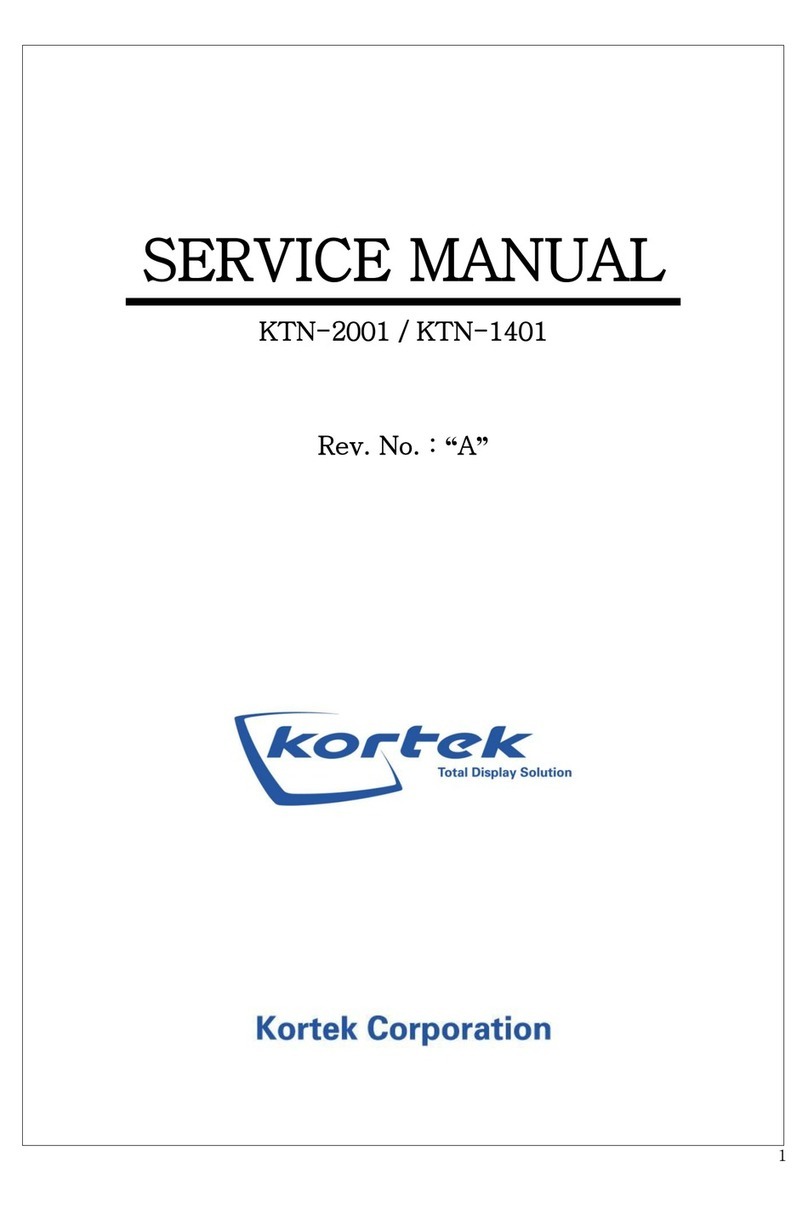Kortek P42SV User manual

SERVICE Manual
Model: P42SV
CONTENTS
1. Precautions
2. Reference Informations
3. Electrical Specifications
4. Alignment and Adjustments
5. Circuit Description
6. Remote Control
7. Installation
8. Wiring Diagram
9. TroubleShooting Intro
10. TroubleShooting
11. Glossary
Plasma Display

Kortek.co.kr
May. 2003
Printed in korea

Kortek corporation 2of 99 PDP R&D Center
INDEX (1 of 2)
1. Precautions…p4
1.1 Safety Precautions
1.2 Servicing Precautions…p7
1.3 Precautions for Electrostatically Sensitive Devices(ESDs)…p8
2. Reference Information…p9
2.1 Tables of Abbreviations and Acronyms
3. Electrical Specifications
3.1 Block Diagram…p11
3.2 Display Performance…p12
3.3 Power…p13
3.3.1 General
3.3.2 Power Management
3.3.3 Input Power Connector Location…p14
3.3.4 Input Power Voltage Source and Pin Assignment…p15
3.4 Video…p16
3.4.1 Input
3.4.2 Supplied Video Timing Chart
3.4.3 Image Outputs Specification…p17
3.4.4 Pin Assignment… p18
4.Alignment andAdjustments…p19
4.1 Service Mode
4.1.1 Service Mode Entry Method
4.1.2 Initial DISPLAY State in times of SERVICE MODE Switch overs
4.1.3 Buttons Operations within SERVICE MODE
4.1.4 White Balance Adjust Method…p20
4.2 Discharge Voltage Adjustment Method…p21
4.3 Fault Finding Using Multimeter…p22
5. Circuit Description…p24
5.1 Power Supply…p25
5.1.1 Power Supply Systematic Diagram & Wiring Diagram
5.1.2 Outline(PDP SMPS)
5.1.3 SMPS Specification…p26
5.2 Driver Circuit…p29
5.2.1 Driver Circuit Overview
5.2.2 Drive Pulse and Functions…p31
5.2.3 Analysis of Driving Pulse…p32
5.2.4 Principle of FET’s Operation and High Voltage Switching.
5.2.5 Driving Circuit Diagram…p33
5.2.6 Base Configuration & Driving Description of Driver…p34
5.3 Logic Part…p36
5.3.1 Block Diagram and Configuration of Logic MAIN Board
5.3.2 An Explanation of logic main board by the block…p37
5.3.3 How to select internal/external CLOCK & NTSC/PAL…p46

Kortek corporation 3of 99 PDP R&D Center
INDEX (2 of 2)
5.4 Image Board…p47
5.4.1 Block Diagram
5.4.2 Description in Signal Process Block…p48
5.4.3 IC Line-Up…p50
5.5 Logic Buffer… p51
5.5.1 Block Diagram of Logic Buffer
5.6 COF(Chip On Flexible)…p52
5.6.1 COF
5.6.2 Function of COF for the purpose of PDP
5.6.3 Base Configuration & driving description of COF
6. Remote Control…p53
7. Installation…p54
7.1 Stand Type
7.1.1 Notice for installing
7.1.2 Method of Installation
7.2 Wall Mount…p55
7.2.1 Notice for installing
7.2.2 Parts
7.2.3 Method of Installation…p56
8. Wiring Diagram…p58
9.Troubleshooting Intro…p59
9.1 No Raster
9.2 Partly no Screen…p60
10. Troubleshooting…p61
10.1 Troubleshooting Procedure in Abnormal Conditions…p62
10.1.1 No Power
10.2 No Video…p63
10.2.1~3 No video(types)…p64
10.3 Abnormal Video…p69
10.3.1~3 Abnormal Video(types)…p70
10.4 Sustain Open…p73
10.5 Sustain short…p75
10.6 Abnormal Suatin…p76
10.7 Abnormal Open…p77
10.7.1 R_Data Address Open…p78
10.7.2 G-Data Address Open…p79
10.7.3 B-Data Address Open…p80
10.7.4 Block Address Open…p82
10.8 Address Short…p84
10.9 Abnormal Address…p85
11. Glossary…p88

Kortek corporation 4of 99 PDP R&D Center
1. Precautions
Follow these safety, servicing and ESD Precautions to prevent damage and protect against potential hazard such
as electrical shock and X-ray
1.1 Safety Precautions
1. Be sure that all of the built-in protective device are replaced. Restore any missing protective shields.
2. When reinstalling the chassis and its assemblies, be sure to restore all protective devices, including:
nonmetallic control knobs and compartment covers.
3. Make sure that there are no cabinet openings through which people-particuarly children ?might insert
fingers and contact dangerous voltages. Such openings include the spacing between the picture tube and
the cabinet mask, excessively wide cabinet ventilation slots, and improperly fitted back covers.
If the measured resistance is less than 1.0 megohm or greater than 5.2 megohms, and abnormality exists
that must be corrected before the unit is returned to the customer.
4. Leakage Current Hot Check(Figure. 1): Warning: Do not use an isolation transformer during this test. Use a
leakage-current tester or a metering system that complies with American National Standards Institute(ANIS
C101.1, Leakage Current for Appliances), and Underwriters Laboratories(UL Publication UL1410, 59.7).
5. With the unit completely reassembled,
plug the AC line cord directly into
the power outlet. With the unit’s AC switch
first in the ON postion and then OFF,
measure the current between a known
earth ground(metal water pipe,Conduit,etc.)
and all exposed metal parts,including:
antennas, handle brackets,Metal cabinets,
screwheads and control shafts. The current
measured should Not exceed 0.5 milliamp.
Reverse the power-plug prongs in the AC Fig.1 AC Leakage Test
outlet and repeat the test.
6. Antenna Cold Check: With the unit’s AC plug disconnected from the AC source, connect an electrical jumper
across the two AC prongs. Connect one lead of the ohmmeter to an AC prong. Connect the other lead to the
coaxialconnector.

Kortek corporation 5of 99 PDP R&D Center
7. X-ray Limits: The picture tube is especially designed to prohibit X-ray emissions. To ensure continued X-
ray protection, replace the picture tube shieds and mounting hardware; these also provide X-ray protection.
8. High Voltage Limits: High voltage must be measured each time servicing is done on the B+, horizontal
deflection or high voltage circuits. Correct operation of the X-ray protection circuits must be reconfirmed
whenever they are serviced.(X-ray protection circuits must be called “horizontal disable”or “hold-
down”)
Heed the high voltage limits. These include the X-ray Protection Specifications Label, and the Product
Safety and X-ray Warning Note on the service data schematic.
9. High voltage is maintained within specified limits by close-tolerance, safety-related components and
adjustments. If the high voltage exceeds the specified limits, check each of the special components.
10. Design Aleration Warning: Never alter or add to the mechanical or electrical design of this unit. Example:
Do not add auxiliary audio or video connectors. Such alterations might create asafety hazard. Also, any
design changes or additions will void the manufacturer’s warranty.
11. Hot Chassis Warning: Some TV receiver chassis are electrically connected directly to one conductor of the
AC power cord. If an isolation transformer is not used, these units may be safely serviced only if the AC
power plug is inserted so that the chassis is connected to the ground side of the AC source.
To confirm that the AC power plug is inserted correctly, do the following: Using an AC voltmeter, measure
the voltage between the chassis and a known earth ground. If the reading is greater than 1.0V, remove the
AC power plug, reverse its polarity and reinsert. Re-measure the voltage between the chassis and ground.
12. Some TV chassis have a secondary ground system in addition to the main chassis ground. This secondary
ground system is not isolated from the AC power line. The two ground systemsare electrically separated
by insulating material that must not be defeated or altered.
13. Components, parts and wiring that appear to have overheated or that are otherwise damaged should be
replaced with parts that meet the original specifications. Always determine the cause of damage or
overheating, and correct any potential hazards.
14. Observe the original lead dress, especially near the following areas: Antenna wiring: sharp edges, and
especially the AC and high voltage power supplies. Always inspect for pinched, out-of-place, or frayed
wiring. Do not change the spacing between components and the printed circuit board. Check the AC power
cord for damage. Make sure that leads and components do not touch thermally hot parts.
15. Picture Tube Implosion Warning: The picture tube in this receiver empolys “integral implosion”protection.
To ensure continued implosion protection, make sure that the replacement picture tube is the same as the
original.

Kortek corporation 6of 99 PDP R&D Center
16. Do not remove, install or handle the picture tube without first putting on shatterproof goggles equipped with
side shields.
17. Product Safety Notice: Some electrical and mechanical parts have special safety-related characteristics
which might not be obvious from visual inspection. These safety features and the protection they give might
be lost if the replacement component differs from the original?even if the replacement is rated for higher
voltage, wattage, etc.
Use replacement components that have the same ratings, especially for flame resistance and dielctric
strength specifications. Areplacement part that does not have the same safety characteristics as the
original might create shock, fire or other hazards.

Kortek corporation 7of 99 PDP R&D Center
1.2 Servicing Precautions
Warning 1: First the “Safety Precautions”section of this manual. If some unforeseen circumstance creates
Conflict between the servicing and safety precautions, always follow the safety precautions.
Warning 2: An electrolytic capacitor installed with the wrong polarity might explode.
1. Servicing precautions are printed on the cabinet. Follow them.
2. Always unplug the unit’s AC power cord from the AC power source before attempting to: (a) Remove or
reinstall any component or assembly, (b) Disconnect an electrical plug or connector, (c) Connect atest
component in parallel with an electrolytic capacitor.
3. Some components are raised above the printed circuit board for safety. An insulation tube or tape is
sometimes used. The internal wiring is sometimes clamped to prevent contact with thermally hot components.
Reinstall all such elements to their original position.
4. After servicing, always check that the screws, components and wiring have been correctly reinstalled. Make
sure that the portion around the serviced part has not been damaged.
5. Check the insulation between the blades of the AC plug and accessible conductive parts(examples: metal
panels, input terminals and earphone jacks).
6. Insulation Checking procedure: Disconnect the power cord from the AC source and turn the power switch ON.
Connector an insulation resistance meter(500V) to the blades of the AC plug.
The insulation resistance between each blade of the AC plug and accessible conductive parts(see above)
should be greater than 1 megohm.
7. Never defeat any of the B+ voltage interlocks. Do not apply AC power to the unit(or any of its assemblies)
unless all solid-state heat sinks are correctly installed.
8. Always connect atest instrument’s ground lead to the instrument chassis ground before connecting the
positive lead; always remove the instrument’s ground lead last.
9. Plasma Display Panels have partial afterimages when a same picture continues to be displayed for a certain
time.
This happens due to the degradation of brightness caused by a scale-down effect.
To prevent such afterimages when displaying a same picture for a certain time, be sure to reduce the level of
brightness and contrast.

Kortek corporation 8of 99 PDP R&D Center
10. Plasma display is an array of pixels(cells). Therefore, if at least 99.9% pixels keep normal, the appropriate
panel is judged as ‘approved product’. Enen though some of pixels keep luminescent or always light off, do
not worry because the panel is approved.
1.3. Precautions for Electrostatically Sensitive Devices(ESDs)
1. Somesemiconductor(“solid state”)devices are easily damaged by static electricity. Such components are
called Electrostatically Sensitive Devices(ESDs): examples include integrated circuits and some field-effect
transistors. The following techniques will reduce the occurrence of component damage caused by static
electricity.
2. Immediately before handling any semiconductor components or assemblies, drain the electrostatic charge
from your body by touching aknown earth ground. Alternatively, wear a discharging wirst-strap device.
(Be sure to remove it prior to applying power-this is an electric shock precaution)
3. After removing an ESD-equipped assembly, place it on aconductive surface such as aluminum foil to
prevent accumulation of electrostatic charge.
4. Do not use Freon-propelled chemicals. These can generate electrical charges that damage ESDs.
5. Use only a grounded-tip soldering iron when soldering or unsoldering ESDs.
6. Use only an anti-static solder removal device. Many solder removal devices are not rated as “anti-static”;
these can accumulate sufficient electrical charge to damage ESDs.
7. Do not remove areplacement ESD from its protective package until you are ready to install it. Most
replacement ESDs are packaged with leads that areelectrically shorted together by conductive foam,
aluminum foil or other conductive materials.
8. Immediately before removing the protective material from the leads of areplacement ESD, touch the
protective material to the chassis or circuit assembly into which the device wiil be installed.
9. Minimize body motions when handling unpackaged replacement ESDs. Motions such as brushing clothes
together, or lifting a foot from a carpeted floor can generate enough static electricity to damage an ESD.

Kortek corporation 9of 99 PDP R&D Center
2. Reference Information
2.1. Tables of Abbreviations and Acronyms
Table 2-1 Abbreviations
AAmpere MV Megavolt
Ah Ampere-hour MW Megawatt
ÅAngstrom MΩMegohm
dB Decibel mMeter
dBm Decibel Referenced to One Miliwatt uA Microampere
℃Degree Celsius uF Microfarad
℉Degree Fahrenheit uH Microhenry
˚KDegree Kelvin um Micrometer
FFarad us Microsecond
GGauss uW Microwatt
GHz Gigahertz mA Milliampere
gGram mg Milligram
HHenry mH Millihenry
Hz Hertz ml Milliliter
hHour mm Millimeter
ips Inches Per Second ms Millisecond
kWh Kilowatt-hour mV Millivolt
kg Kilogram nF nanofarad
kHz Kilohertz ΩOhm
KΩKilohm pF Picofarad
km Kilometer lb Pound
Km/h Kilometer Per Hour rpm Revolutions Per Minute
kV Kilovolt rps Revolution per Second
kW Kilowatt sSecond(Time)
ILiter VVolt
MHz Megahertz VA Volt-ampere
Wh Watt-hour WWatt

Kortek corporation 10 of 99 PDP R&D Center
Table 2-2 Table of Acronyms
ABL Automatic Brightness Limiter I/O Input/Output
AC Alternating Current LLeft
ACC Automatic Chroma Control LLow
AF Audio Frequency LED Light Emitting Diode
AFC Automatic Frequency Control LF Low Frequency
AFT Automatic Fine Tuning MOSFET
Metal Oxide Semiconductor Field Effect TR
AGC Automatic Gain Control MTS Multi-channel Television Sound
AM Amplitude Modulation NAB National Association of Broadcasters
ANSI American National Standards Institude NEC National Electric Code
APC Automatic Phase Control NTSC National Television Systems Committee
APC Automatic Picture Control OSD On Screen Display
A/V Audio-Video PCB Printed Circuit Board
AVC Automatic Volume Control PLL Phase Locked Loop
BAL Balance PWM Pulse Width Modulation
BPF Bandpass Filter QIF Quadrature Intermediate Frequency
B-YBlue-YRRight
CATV Community Antenna Television(Cable TV) RC Resistor & Capacitor
CB Citizens Band RF Radio Frequency
CCD Charge Coupled Device R-YRed-Y
CCTV Closed Circuit Television SAP Second Audio Program
Ch Channel SAW Surface Acoustic Wave(Filter)
CRT Cathode Ray Tube SIF Sound Intermediate Frequency
CW Continuous Wave SMPS Switching Mode Power Supply
DC Direct Current S/N Signal/Noise
DVM Digital Vot Meter SW Switch
EIA Electronics Industries Association TP Test Point
ESD Electrostatic Discharge TTL Transistor Transistor Logic
ESD Electrostatically Sensitive DeviceTV Television
FBP Feedback Pulse UHF Ultra High Frequency
FBT Flyback Transformer UL Underwriters Laboratories
FF Flip-Flop UV Ultraviolet
FM Frequency Modulation VCD Variable Capacitance Diode
FS Fail Safe VCO Voltage Controlled Oscillator
GND Ground VCXO Voltage Controlled Crystal Oscillator
G-YGreen-YVHF Very High Frequency
HF High-Frequency VIF Video Intermediate Frequency
IC Inductance-Capacitance VR Variable Resistor
IC Integrated Circuit VTR Video Tape Recoder
IF Intermediate Frequency TR Transistor

Kortek corporation 11 of 99 PDP R&D Center
3. Electrical Specifications
3.1. Block Diagram

Kortek corporation 12 of 99 PDP R&D Center
3.2 Display Performance
No Item Rating
1 Display Pixels Horizontal 852 ×Vertical 480 pixels
(1 pixel = 1 R,G,B cells)
2 Display Cells Horizontal 2556 ×Vertical 480 cells
3 Pixel Pitch Horizontal 1.08 ×Vertical 1.08 ㎜
4 Cell Pitch Horizontal 1.08 ×Vertical 1.08 ㎜
5 Cell Arrangement R,G,B Stripe
6 Effective Display Size Horizontal 920.16㎜×Vertical 518.4㎜
[ 36.23 inch (H) ×20.41 inch (V) ]
7 Number of Color 16.77 million colors
8 Brightness
(Peak Brightness)Typical 400cd/㎡(PC MODE, LVDS input)
9 Contrast Ratio
(in dark room) Typical 550:1
10 Chromaticity Coordinates
(Typical Value) White : X = 0.285±0.03 Y = 0.290±0.03
11 Viewing Angle Over 160°

Kortek corporation 13 of 99 PDP R&D Center
3.3 Power
3.3.1 General
Input Voltage: 100~240Vac
Input Frequency: 50/60 Hz
Power Consumption: 320W(MAX)
3.3.2 Power Management
Power-saving Function Mode
State Normal
Operation Stand-by Mode Suspend Mode
Position A1
Power-off Mode
Position A2
Horizontal Sync Active Inactive Active Inactive
Vertical Sync Active Active Inactive Inactive
Video Active Blacked Blanked Blanked
Power Indicator Green Amber Blinking
(0.5 sec Interval)
Amber Blinking
(0.5 sec Interval)
Amber Blinking
(0.5 sec Interval)
Notes:
▶This monitor automatically returns to normal operation when horizontal and vertical sync return.
▶This occurs when move the computer’s mouse or press a key on the keyboard.
▶For energy conservation, turn your monitor OFF when it is not needed, or when leaving it
unattended for long periods.

Kortek corporation 14 of 99 PDP R&D Center
3.3.3 Input Power Connector Location(Except An Image Board)
* Layout Schematic is viewed from back side of PDP Module.
* Input Power Connector is denoted as
* The Input Power Connector in Y-Drive Board is named as “SY”.
* The Input Power Connector in X-Drive Board is named as “SX”.
* The Input Power Connector in Logic Board is named as “SL”(The Column Drive Board is named as “BUFFER”).
* “SI”is same “SA”.

Kortek corporation 15 of 99 PDP R&D Center
3.3.4 Input Power Voltage Source and PinAssignment
Caution: If you would control at will(not in SPEC), SMPS may operate ‘protection’mode.
Connector Name
(SY)
Connector Name
(SX)
Connector Name
(SA)
ConnectorName
(Audio)
ConnectorName
(SL)
Pin
No
Voltage
Source
Pin
No
Voltage
Source
Pin
No
Voltage
Source
Pin
No
Voltage
Source
Pin
No
Voltage
Source
15Vd 1Vd(5V) 15Vsb 1V5A 1Vd(5V)
2GND 2GND 2GND 2GND-A2GND
318Vg 318Vg 3GND-D3V9A 3Vd(5V)
4GND 4GND 4V5d1 4V12A 4GND
579Vscan 5190Ve 5RELAY 5GND-AConnectorName
(Buffer)
6GND 6GND 6No
Connection
6VAMP Pin
No
Voltage
Source
7220Vset 779Vscan 7FAN_DET 7VAMP 170Va
8No
Connection
8GND 8GND_A 8GNDS 270Va
9GND 9GND 9GND_A 9GNDS 3No
Connection
10 GND 10 165Vs 10 No
Connection
10 4GND
11 165Vs 11 165Vs 11 V12(A) 11 5GND
12 165Vs 12 165Vs 12 V5a 12
13 165Vs 13 NC 13

Kortek corporation 16 of 99 PDP R&D Center
3.4 Video
3.4.1 Input
Signal: Red, Green, Blue
Polarity: Positiv or Negative H&V Separate Sync
Level: 0.7Vp-p
3.4.2 Supplied Video Timing Chart
IBM/VES 12345678910
Originator
IBM IBM IBM VESA VESA VESA VESA VESA VESA VESA
VGA1 VGA2 VGA3 640x350
640x400
720x400
640 800 800 800
70Hz 70Hz 60Hz 85Hz 85Hz 85Hz 72Hz 56Hz 60Hz 72Hz
H-640 720 640 640 640 720 640 800 800 800
V-350 400 480 350 400 400 480 600 600 600
H-31.469
31.469
31.469
37.861
37.861
37.927
37.861
35.156
37.879
48.077
V-70.086
70.087
59.940
85.080
85.080
85.039
72.809
56.250
60.317
72.188
H-Sync PNNPNNNN or P
PP
V-Sync NPNNPPNN or P
PP
VESA 11 12 13 14 15 16 17 18 19 Refere
Originator
VESA VESA VESA VESA VESA VESA VESA VESA Wide
1024 1024 640 800 1024 640 800 1024 800
60Hz 70Hz 75Hz 75Hz 75Hz 85Hz 85Hz 85Hz 60Hz
H-1024 1024 640 800 1024 640 800 1024 852
V-768 768 480 600 768 480 600 768 480
H-48.363
56.476
37.500
46.875
60.023
43.269
53.674
68.677
31.723
V-60.004
70.069
75.000
75.000
75.029
85.008
85.061
84.997
59.968
H-Sync NNNPPNPPP
V-Sync NNNPPNPPP
The
Time19
Is
Optional

Kortek corporation 17 of 99 PDP R&D Center
3.4.3 Image Outputs Specification
Item SPEC
PC: Format Mode Page18
HDTV:480p(60Hz)/720p(60Hz)/1080i(50/60Hz)
Video, S-Video, DVD
3-Audio L/R Input(PC, Video/S-Video, DVD/DTV)
Input Mode
3W/CH
Color System NTSC/PAL
RGB, H, V………………….15Pin mD-Sub (Analog)
Y/Cb/Cr or Y/Pb/Pr………RCA 3pin(Analog)
Video………………………..RCA 1pin
Input Jack
S-Video…………………….S-Video Jack
Pixelworks Image Scaler
A/D Converter(AD9884A)
Video doubler(gmVLX1A-X, gmAFMC)
Hardware
RGB Processor(CXA2101), Video Decoder(VPC3230D)
Factory Mode Device Adjustment, White balance, Aging Mode, Reset
Separate Graphic & Video Image Processing
Image
Processing Deinterlacing /Nonlinear Scaling/Zoom
OSD 448*296/5 Main Menus(Picture, Setup, OSD, Audio, Time)/16 Color/ English or English &
French(optional)
Function Auto Adjustment(Gain/Phase/Frequency/Position)/Aspect Ratio Control/Time & Sleep Time
Setting(RTC)
Basic Audio Effect Adjustment(Volume, Balance, Treble, Gbass, Middle)
DDC DDC2B
Power Save Power Saving Mode
Pixel Shift 4Pixels(left,right,up,down), 4min
External RS232C (Controlled by PC), 1:1

Kortek corporation 18 of 99 PDP R&D Center
3.4.4 PinAssignment
15P D-Sub Din S-Video Jack
Pin
No Signal Name Pin
No Signal Name Pin
No Signal Name Pin
No Signal Name
1Red Signal 9NC 1GND 9GND
2Green Signal 10 IDENT PC 2GND
3Blue Signal 11 GND 3LUMA
4GND 12 I2C_SDA 4CHROMA
5NC 13 HS 5NC
6R_GND 14 VS 6NC
7G_GND 15 I2C_SCA 7DET_SVHS
8B_GND 8NC
RCA Video Jack RCA 233 Phone Jack RCA 3-Din Jack
Pin
No Signal Name Pin
No Signal Name Pin
No Signal Name Pin
No Signal Name
1GND 1RXD 1GND 6Pr(Cr)
2CVBS Signal 2NC 2GND 7IDET_DTV/
DVD
3IDET_CVBS 3NC 3GND 8NC
4TXD 4Y9NC
5GND 5Pb(Cb)

Kortek corporation 19 of 99 PDP R&D Center
4. Alignment and Adjustments
4.1 Service Mode
4.1.1 Service Mode Entry Method(General Transmitter)
1. Turn off the power to make the SET STAND-BY mode.
2. In order to enter the Service Mode, select Mute-1-8-2-Power.
▶In case entry into SERVICE MODE is unsuccessful, repeat the procedures above.
( Warning : Don’t entry into Aging Mode. If you do that, you cann’t back User Mode )
4.1.2 Initial DISPLAY State in times of SERVICE MODE Switch overs
1. Service Mode Select 2. Device Adjustment 3. White Balance
Service Mode Select
Device Adjustment
White Balance
Aging Mode
Reset
Ver 3.0
Device Adjustment
CXA2101
VPC3230 Main
Auto Pixel Shift
White Balance
R-Gain 127
G-Gain 127
B-Gain 127
R-Offset 127
G-Offset 127
B-Offset 127
Gain Max 48
Center Offset 144
4.1.3 Buttons Operations within SERVICE MODE
Menu Entire menu display
Joystick UP/DOWN Cursor move to select items
Joystick LEFT/RIGHT
Enable to increase and decrease the data of the selected items
▶Notice: In case of no signal in DTV MODE or PC MODE, entry into the FACTORY MODE cannot be mode.
Table of contents
Other Kortek Monitor manuals
























